
Phoebe’s booth featuring work by Sophie Friedman-Pappas, Cecilia Salama, and Madeline Seely.
Paddy: The Artist-Run Art Fair returned for its third year inside of an old parking garage as part of Baltimore’s annual Artscape festival. The festival itself began rather slowly Friday afternoon, as if the entire city was suffering from a giant case of heat stroke. I watched a guy sitting in an ice cream truck a block away from the fair tell one kid after another that no ice cream could be purchased because the machines were broken. In an adjacent parking lot to Artist Run, bands played continuously throughout the day. That meant that the noise inside the fair was insufferable. Eventually, I went outside to see the band, only to learn that they were playing to all of five hippies, only one of whom was high enough to enjoy the music.
So, that was the scene Friday afternoon. Not perfect art viewing conditions, but a far more democratic approach than the usual destination art event. (You know, take a boat to an island, fly a jet to Switzerland, spend a week in foreign city for a Biennale.)
In years past we’ve praised the fair for this kind of democracy—this time around, I found it hard to rekindle the same enthusiasm. In part, this was a response to some of the more conventional booths. But was it anything else? Looking back at my photos, I’m wondering whether my first impression holds up. Even if I wasn’t thrilled with everything, there’s quite a lot worth discussing. Thoughts?

Jerry Williams, “Ringling Bros. Mongolian Strongmen & Body Benders,” at Make Studio, a nonprofit that offers resources and representation to adult artists with disabilities. This was one of the few booths with visible prices on everything, and it was all as delightfully affordable.
Michael: About fifteen feet into the garage, I was struck by the impression that the scrappy Artist-Run Art Fair had suddenly started to look much more like… an art fair. That might be attributed to the surprising number of larger sculptural works from out-of-town galleries. But we had also just been approached by a gallerist who was bemoaning that Miami’s Artist-Run Show had been subsumed into a much-more expensive fair. Here though, the changes seemed relatively benign: local collective Open Space has kept the fair affordable for DIY spaces, and free and accessible to the public. One thing I did miss this year: visible prices on everything. In years past, it was nice to see lots of work at different price points. We both commented on how exciting it was to actually be able to purchase artworks (even if they were prints or small ceramics) at a fair. This year, it didn’t even occur to me to consider buying any of the larger sculptures or paintings—even in such a low-key, DIY context, it’s hard to shake that “if you have to ask, you can’t afford it” adage. That said, I would totally collect a lot of what’s on view here.
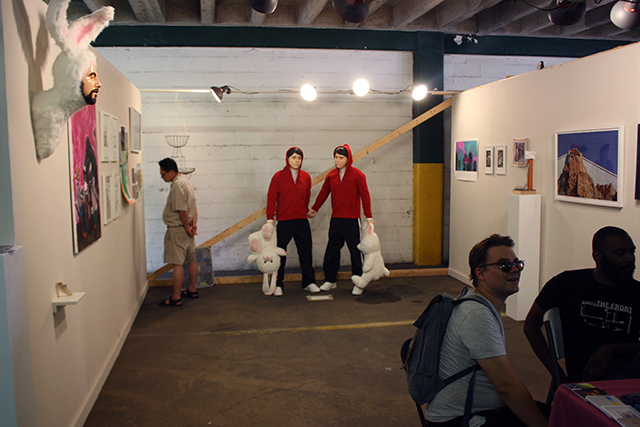
The Front (from New Orleans) at The Artist-Run Art Fair
Paddy: I’m just going to pipe in here and say that I had didn’t have problems with a lot of the sculptural work brought in from out of town, barring Alex Podesta’s “Trophy” , on view at The Front, New Orleans. The original piece, “Self Portrait as Bunny” was made up of two identical busts crafted in Podesta’s image and wearing bunny suits. I first saw them in Grand Rapids for Artprize and the big talking point there was that the sculpture’s gaze was downward cast, which apparently gave it more depth. Their eyes never meet—what could this mean? This time, there’s only one man in a rabbit suit, and it’s as vacuous as the diptych.
In any event, between that booth and Short House, from L.A., which brought a whole slew of banal wall mounted work, I was pretty much convinced that the fair could stand to be a bit more picky about the outside talent they invited.
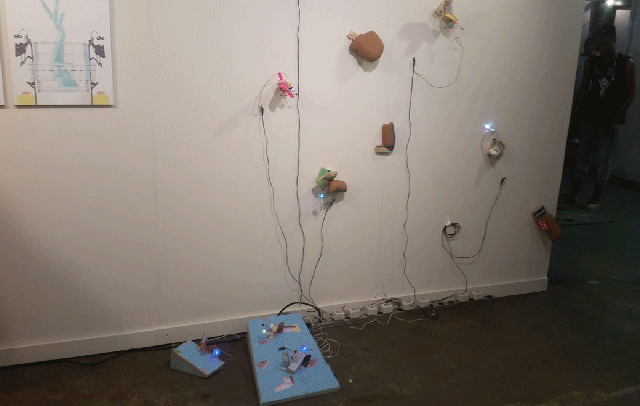
Bonnie Crawford Kotula at Terrault Contemporary (Baltimore). These were accompanied by tiny assemblages in viewfinders that were pretty fun.
Michael: Oh I don’t mind sculpture either! I really liked most of the pieces (especially the almost-certainly-not-potable water fountains at Houseboy, Open Space, and Good Weather and weird LED pieces at Terrault) and didn’t mean that comment as a negative at all. It’s just an observation that large sculptures on the floor flanked by more conventionally-presented 2D work on walls screams “you’re in an art fair!” at me in a way I hadn’t quite experienced here in years past. But yeah, Podesta’s bunny self portraits looked like they belonged at Scope. I liked most of the paintings in The Front’s space though, in particular Patch Somerville’s paintings of palettes and his trompe l’oeil box fan. They communicate a real joy of painting, and combined with the garage aesthetic totally felt more like a studio visit than a fair booth.
Paddy: Really? That booth was a real mixed bag if you ask me. I thought the photograph Jonathan Traviesa of the mountain in front of the building with a mountain painted on it was pretty funny, though I think there are better examples of photography in that genre. Thomas Albdorf comes to mind. I also enjoyed Lee Delgaard’s quadruplet of muted tone landscape pigment prints. But a lot of the work in that booth I doubt we’d spend any time talking about if the fair were even a bit larger. Like, Somerville’s painting of the box fan? I did not care for that piece. I wouldn’t describe it as trompe l’oeil—there’s not nearly enough skill in the rendering—and in a very obvious move, it was positioned on the floor, just like a regular fan. How dumb do they think we are?
Michael: Okay, it’s not quite rendered realistically, but from the corner of my eye I got really excited at the prospect of an actual fan (it was about 100 degrees when we visited). I fell for the trap. I respect any artwork that gives me that much of a visceral reaction.
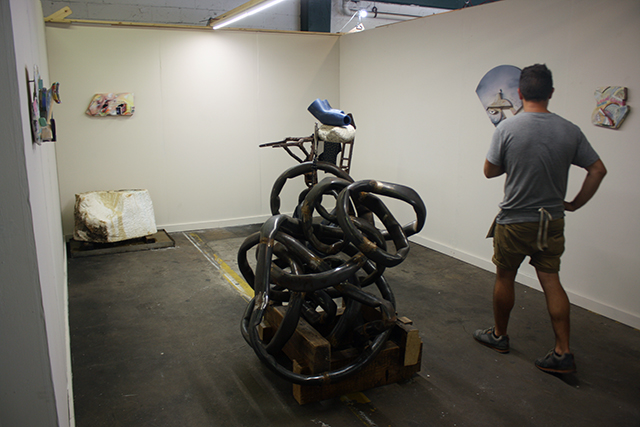
Dan Roberts and Willie Wayne Smith at Good Weather (Little Rock, Arkansas)
Paddy: Speaking of sculpture, I’d like to second your nod to the Daniel Roberts sculptures at Good Weather. “East River Bench,” a fountain made from some disgusting found styrofoam couldn’t be more abject. (Frankly, the work isn’t that much cleaner than the place its materials were sourced—the East River.) These days most garbage art gets cleaned up nicely enough that collectors will want it in their homes. It’s nice to see a bit of push back to that commercial world, while being true to the source material.
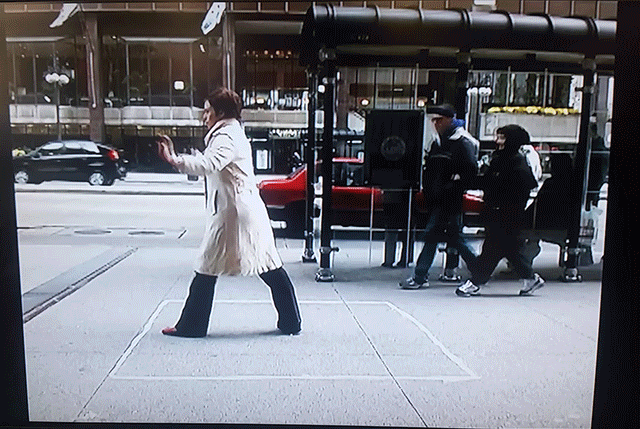
Lilly McElroy, “The Square – After Roberto Lopardo,” 2004 at Open Space.
Michael: Open Space continually hits all the right notes with art that’s subtly integrated into the trashscape paired with funny video work. Here we see a woman furiously defending a square on the sidewalk. If you’re protective of your personal space in big crowds, Artscape might not be the place for you. And I think every art fair visitor has encountered some territorial patrolling of one’s assigned white box. This piece works on a lot of levels, including a lot of awkward moments when she becomes confrontational. It’s a bit like watching one of those episodes of Seinfeld where Elaine gets in a fight with strangers over nothing and it’s equally funny and cringe-inducing.
Paddy: This piece looks great and I’m bummed that I totally missed it at the fair! I focused more on the Jason mask in this booth, which was rendered in home depot clay and yellow twine used on construction sites. Has gentrification killed the horror movie? The piece makes no sense, and I love it for that.

Max C Lee at Houseboy (Pittsburgh).
Michael: Houseboy, a space from Pittsburgh that may-or-may-not actually exist IRL (googling them brings up mainly “rent boy” websites) had one of the more memorably strange booths. Seemingly-appropriated homoerotic images of young men gathered by Stephen Grebinski found themselves on walls, stacked on cinderblocks on the floor, and playing on intimately-scaled video screens. They’re creepily voyeuristic and suggest a kind of pulp disposability/lack of preciousness that gives them a vaguely predatory quality. If this booth had a themesong, it might be the iconic electroclash sleaze anthem “Seventeen” by Ladytron. It’s not the kind of content one would expect at a public art festival. But it is the kind of content one might encounter in a dark parking garage afterhours in this neighborhood, so kudos for a surprising take on contextuality!
The somewhat-dated look of the images suggested that maybe these men have outgrown their “houseboy” years by now. And that idea of an image/body/object having obsolete seductive potential was echoed by Max C Lee’s giant fountain of trash in the center of the booth. Green water streams out of a busted TV, over cracked iPhones, and through a grid of plastic bottles. The piece seemed to be a big crowd-pleaser, but effectively stirred up some of my biggest anxieties.
I am literally on the verge of a panic attack every time I have to discard or purchase an electronic device because of how toxic (and now ubiquitous) the components are. The world is drowning in heavy-metal-laden “e-waste” and the Pacific ocean is rapidly filling up with plastic. Nearly everything we have ever owned has already spent most of its 10,000+ year lifespan as toxic waste that’s slowly tainting our water supply, far moreso than the comparably small amount of time we enjoy a bottle of water or one-year of smartphone use before an upgrade. Will all of our water be this color in a few decades? Probably under blacklight.
Paddy: Stephen Grebinski apparently found a vast archive of vintage gay porn online and was able to download it. Oddly enough, the images, even when collaged, looked familiar to me.
Michael: Haha! I think that might have something to do with the frequency we end up at art shows with public-domain queer imagery than your internet browsing habits, Paddy.
Paddy: Actually, I’m pretty sure it’s because I saw the same images used by Brian Ganter at Transformer Station while I was in Cleveland earlier this year. He’d created heat sensitive tintypes that when warmed, reveal portraits of gay porn stars who had died of AIDS.
What does that say about the work? Probably nothing. For the vast number of images out there, it seems we still end up looking at the same ones. I will say that I didn’t find the collages all that accomplished. The collages, at times, seemed a bit directionless. An image of a guy cumming is duplicated and overlaid on itself. Another image shows the outline of a butt plug. Another still wraps a man’s profile in curtains. I think there’s some interest in domesticity there, but it’s not very specific and I felt with the feeling that Grebinski was still figuring out what to do with the archive.

“White Guilt Confessional” by April Danielle Lewis presented by LABBODIES. Curated by: Hoesy Corona and Ada Pinkston (founding co-directors of Labbodies)
Paddy: So, the elephant in the room: “White Guilt Confessional” by April Danielle Lewis. Art fairs are usually filled with white people, which provides at least sizable pool of potential participants. According to the co-curator, Hoesy Corona, who is stationed outside the frame of this picture and well away from the booth, people approach the confessional in the same way. They look to see if someone is actually behind the booth, see that there is, and do one of three things: walk away, talk to him, or use the booth.
I spoke to Corona and read some of the literature about how “unhealthy white guilt promotes a privileged refusal to engage in conversations and actions about race for fear of feeling bad”. I didn’t use the booth. It wasn’t about fear of feeling or that I don’t have any white guilt to share. Given that I’d already decided that not writing about the piece would be its own kind of racism, I really wanted to have an actual experience to share. But ultimately, the booth was nowhere near private enough for me to feel comfortable doing so. We’ve all said and done things related to our privilege that have made us ashamed. Those kinds of memories don’t get shared in an open room for everyone to hear.
Michael: But increasingly, it seems like white guilt has become the very publicly-traded currency of art discourse in Baltimore. Which makes the confessional an interesting object, because it both acknowledges that what we refer to as “identity” is about performing a somewhat scripted ritual and draws a parallel to “original sin”. Religions exact their power from the message that there’s something inherently wrong with humanity, and that often aligns with how people conceptualize race—from a “Chosen People” to “The Mark of Cain”. We haven’t yet been prescribed any one secular panacea for the myriad sins-of-the-father we inherit these days, but it’s sadly not likely to be as simple as saying a dozen Hail Marys and eating magic bread—or even lopping off one’s foreskin. I guess that’s why I also didn’t use it.

Platform Gallery (Baltimore).
Michael: To end on a lighter note, I love that Platform Gallery brings a fun, total transformation to every fair in which they set up shop. Above we have a bunch of very different works—from a mysterious silver fabric lump propped in the corner by Stewart Watson to neon mirrors from Esther Ruiz—staged in a surreal living room. The gallerists wanted to stress the weirdness that we usually make art for display in a white cube, but it often ends up in one’s home. How would a couch look pointed at a three-channel video installation as opposed to a single TV? Here, we get an idea.
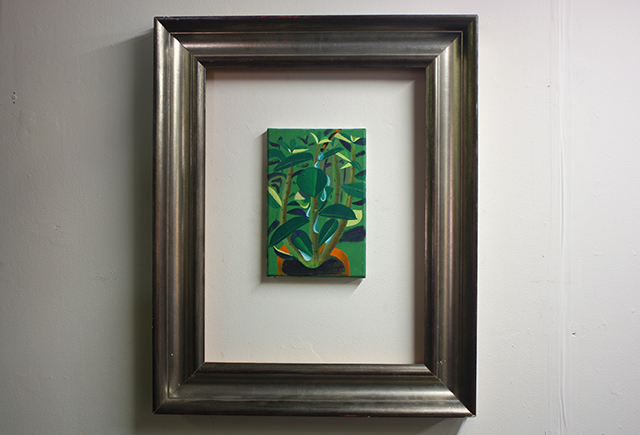
Louis Fratino, “Desert Rose” at Platform. Fratino has a solo show opening at the gallery’s brick-and-mortar location in Baltimore on August 13th.
And of course it wouldn’t be a contemporary art fair without houseplant art. Add this to the column of art I’d probably buy, though my domestic environment is oversize-frame-free.
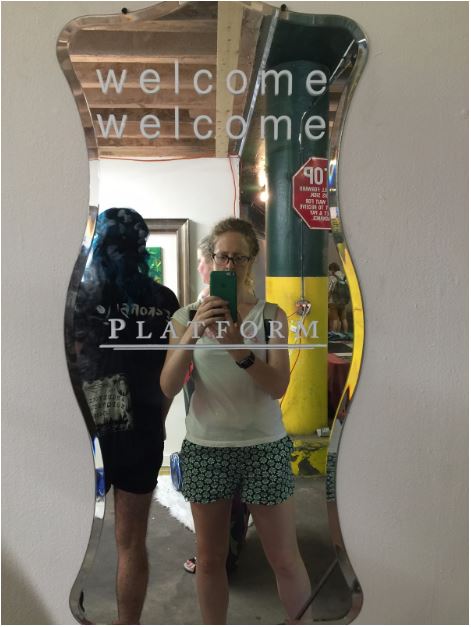
Paddy: And some selfie friendly art! Platform hit all the nails on the head this time around.


Comments on this entry are closed.